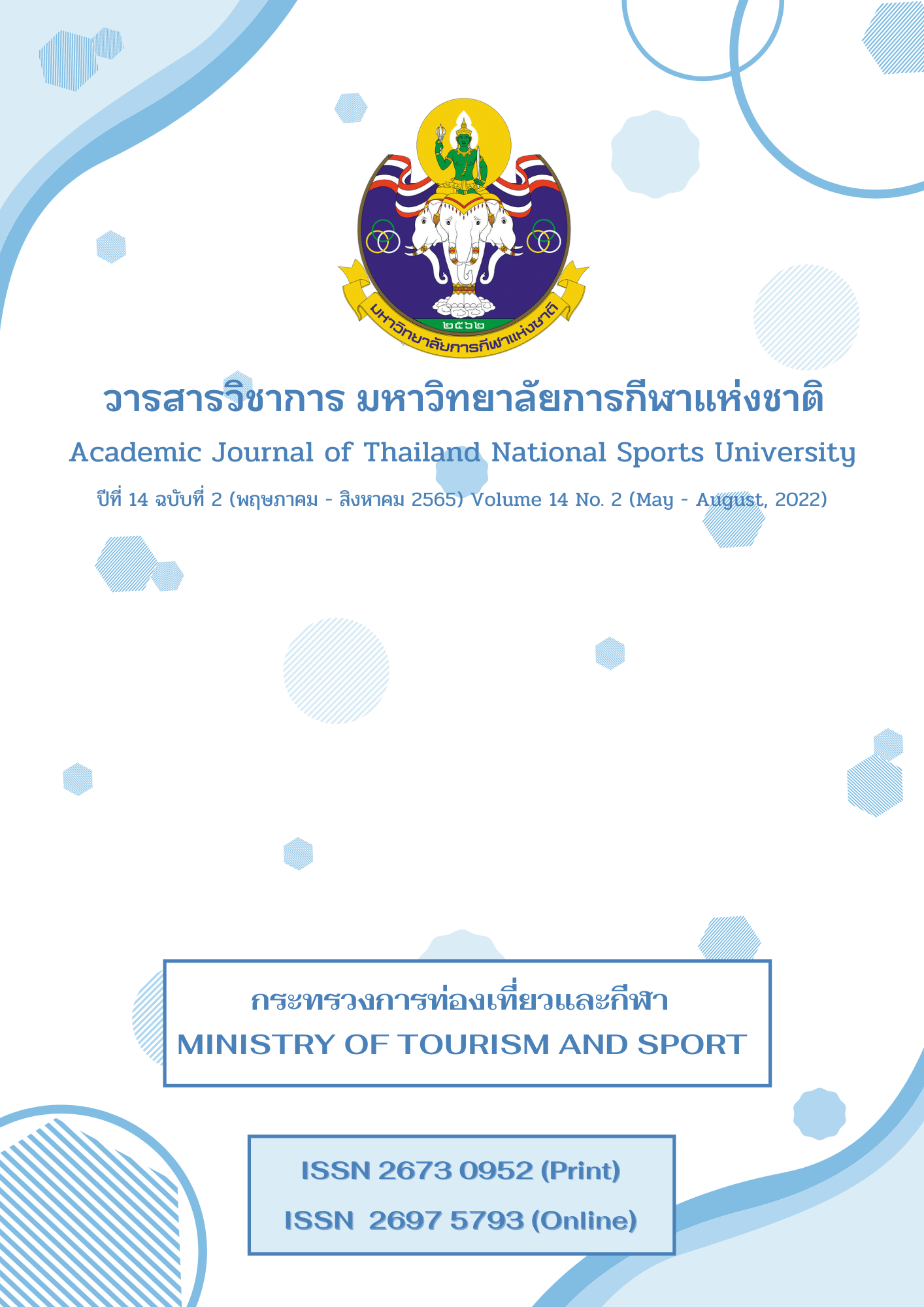JUDO TRAINING PROGRAM WITH MENTAL REHEARSAL ON THROWING SKILLS OF YOUNG ATHLETES
Main Article Content
Abstract
The objective of this research was to develop Judo training program by combining mental rehearsal on two skills of Judo throwing which are Morote Seoi Nage and O Goshi. This was done through efficiency comparison during (E1) and after (E2) training and comparison of throwing skill results prior to and after training week 4 and week 8. 20 Lao youth Judo athletes, aged between 14 to 18 years old were selected as a sample group and they were trained two days per week for eight weeks. Judo training program with mental rehearsal in recorded scores of two throwing skills was used as an analysis tool. Statistics used in analyzing data were mean, standard deviation, repeated measure design at the statistical significance level of .05.
The research was found that:
- The results of score analysis of two style of throwing skills during and after training revealed that the E1/E2 efficiency was higher than the determined criteria (80/80) and the results of mean difference test by using t - test of two styles of throwing skills before and after training revealed that the scores were 81/87 and 83/91 respectively. This result indicated that the success of using training program with mental rehearsal after experimenting was higher than that in pre - experiment.
- The results of the analysis of repetitive variance within the sample, The Morote Seoi Nage throwing skill had a statistical significant difference at the level of .05 and the Ogoshi throwing skill had a statistical significant difference at the level .05.
The results of data analysis comparing the two throwing skills of the samples between Week 1 and Week 4, Week 4 and Week 8 and Week 1 and Week 8 revealed that increasing statistical significance was found at level of .05.
Article Details

This work is licensed under a Creative Commons Attribution-NonCommercial-NoDerivatives 4.0 International License.
The published article is a copyright of the Academic Journal of Thailand National Sports University. The passage appeared in each article in this academic journal is a perspective of each author which is not related to the journal. Each author is required to be responsible for all components of his/her own article. If there are any mistakes, each author must be responsible for those mistakes on his/her own.
References
Amorntat Akkapoo. (2008). Judo’s training problems in sports schools under, the office of Sport and Recreation Development, Ministry of Tourism and Sports (Master’s thesis), Srinakharinwirot University.
Anon Pumkhun. (2005). Effects of pre - and post - penalties imagery practice on penalty kick accuracy in football (Master’s thesis), Kasetsart University.
Chanwit Intharak. (2016). Effect of visualization training with relaxation instrumental music that affects physical relaxation situational anxiety and accuracy in dart throwing in young athletes. Chonburi: Faculty of Sports Science, Burapha University.
Guillot, A., Nadrowska, E., & Collet, C. (2009). Using motor imagery to learn tactical movements in basketball. Journal of Sport Behavior, 32, 189 - 206.
Hall, E., & Erffmeyer, E. S. (1983). The effect of visuo - motor behavior rehearsal with videotaped modeling on free throw accuracy of inter - collegiate female basketball players. Journal of Sport Psychology, 5, 343 - 346.
Hasan Abdi, Elham Mahmoodifar, Hassan Gharayagh Zandi and Mohammadsaleh Abdi. (2012). The effect of mental and physical practice and its combination on badminton short serve learning. European Journal of Experimental Biology, 2(4), 909 - 912.
Kavoura Anna. (2009). An imagery intervention for highly skilled judo athletes (Master’s thesis), University of Jyväskylä. Retrieved from https://jyx.jyu.fi/bitstream/handle/ 123456789/22438/URN_NBN_fi_jyu-200911174414.pdf?sequence=1&isAllowed=y
Kusuma Bouayai. (2015). Comparative effects of plyometric training with medicine ball and elastic band on speed of Judo throwing. Chiangmai University.
Narumol Chansuk, & Peerapong Boonsiri. (2018). The effects of imagery training on the archery precision of archers in Lampang Province (Master’s thesis), Institute of Physical Education Chiang Mai Campus.
Nataorn Teekayupuk. (2014). Scoring rubrics construction of judo skills for undergraduate students of Kasetsart University (Master’s thesis), Kasetsart University.
Nomura, T. (1999). Gijutsu kyouka kouza (Technical Seminar). Kindai Judo (Modern Judo), 21(4), 26 - 27.
Nopporn Tasnaina. (2011). Badminton trainer scripture. Nakhon Si Thammarat: Walailak University.
Nopporn Tasnaina. (2015). Selected substances for badminton trainers. Chonburi: Faculty of Sports Science, Burapha University.
Ratdech Kruatiwa. (2010). The effect of music listening combined with imagery training on accuracy of Basketball Free – Throw (Master’s thesis), Srinakharinwirot University.
Sasima Pakulanon, & Nipawan Kantha. (2015). The results of serving skill training coupled with mental rehearsal with music listening on serving precision in Sepak Takraw athletes, Mae Fah Luang University. Chiang Rai: Office of Health Sciences Mae Fah Luang University.
Sato, N. (2005). JUDO waza no daihyakka (Encyclopaedia of JUDO techniques). Baseball Magazine sha.
Suebsai Bunweerabutr. (1998). Sports psychology. Chonburi: Chonburi Printing.
Supranee Kwanboonchan. (1998). Psychology of Sports. Bangkok: Thai Wattana Panich.
Suthasinee Vechprahman, Mayuree Supawibun, & Phichit Muangnapho. (2012). Effects of Anapanasati meditation and visualization on basketball penalty shootability. Bangkok: Faculty of Physical Education Srinakharinwirot University.


